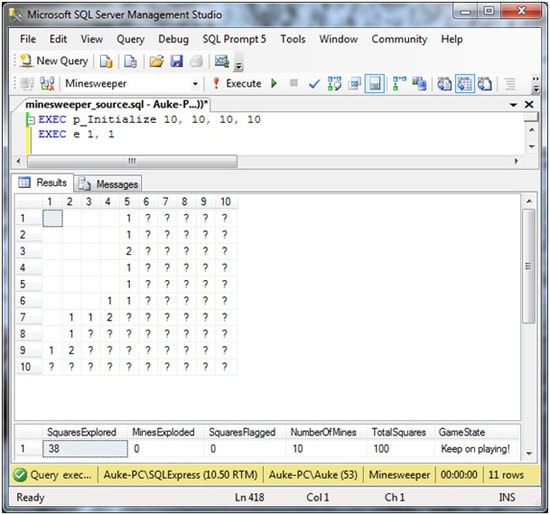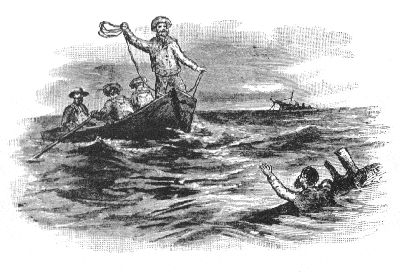Whatever happened to the idea that programming in TSQL can be fun? A Simple-Talk reader contributes an article to remind us all that there is more to TSQL than wrestling with DMVs and pummelling recalcitrant correlated subqueries.
/* As a fun exercise I decided to program Minesweeper in T-SQL. I think it worked out quite nicely, so I’d like to share it with the world. But first, for anyone who doesn’t know what minesweeper is, a description is available here.

I’ve used SQL Server Management Studio 2008 Express, but other versions should work as well (although the layout of the resultgrid might require some work).
I wanted a minefield that was variable in length and width, so I created three tables: */
CREATE TABLE Grid
(
X INT NOT NULL, — X coordinate
Y INT NOT NULL, — Y coordinate
S INT NULL, — Status, see the user defined function udf_S
CONSTRAINT PK_Grid PRIMARY KEY (X ASC, Y ASC)
)
CREATE TABLE Mine
(
X INT NOT NULL, — X coordinate
Y INT NOT NULL, — Y coordinate
CONSTRAINT PK_Mine PRIMARY KEY (X ASC, Y ASC)
)
/* The setting table will only ever hold one record */
CREATE TABLE Settings
(
MaxX INT NOT NULL, — Number of rows
MaxY INT NOT NULL, — Number of columns
NumberOfMines INT NOT NULL
)
/* Inserting some default values */
VALUES (10, 10, 10)
GO
CREATE FUNCTION udf_S (@S INT)
RETURNS CHAR(1)
BEGIN
RETURN (CASE
WHEN @S = -100 THEN ‘F’ –Flagged
WHEN @S = -10 THEN ‘S’ –Safe
WHEN @S = -1 THEN ‘?’ –Unknown
WHEN @S = 0 THEN ” –No mines in the vicinity
WHEN @S = 9 THEN ‘M’ –Exploded mine
ELSE CONVERT(CHAR(1),@S)
END
)
END
GO
CREATE PROCEDURE p_Initialize
(
@MaxX INT = NULL,
@MaxY INT = NULL,
@NumberOfMines INT = NULL,
@Seed INT = NULL
)
AS
BEGIN
UPDATE Settings
SET MaxX = ISNULL(@MaxX, MaxX),
MaxY = ISNULL(@MaxY, MaxY),
NumberOfMines = ISNULL(@NumberOfMines, NumberOfMines)
SELECT @MaxX = MaxX,
@MaxY = MaxY,
@NumberOfMines = NumberOfMines
FROM Settings
TRUNCATE TABLE Mine
TRUNCATE TABLE Grid
DECLARE @x INT
DECLARE @y INT
/* Creating records to represent the squares of the grid */
WHILE @x <= @MaxX
BEGIN
SET @y = 1
WHILE @y <= @MaxY
BEGIN
INSERT INTO grid
VALUES (@x, @y, -1)
SET @y = @y + 1
END
SET @x = @x + 1
END
IF @seed IS NOT NULL
SET @x = RAND(@seed)
/* Dropping mines, but never on the same square */
WHILE @NumberOfMines > 0
BEGIN
SET @x = FLOOR(RAND() * @MaxX) + 1
SET @y = FLOOR(RAND() * @MaxY) + 1
IF (SELECT COUNT(*)
FROM mine
WHERE x = @x
AND y = @y
) = 0
BEGIN
INSERT INTO Mine
VALUES (@x, @y)
SET @NumberOfMines = @NumberOfMines – 1
END
END
END
GO
CREATE PROCEDURE p_Draw
AS
BEGIN
DECLARE @sql VARCHAR(MAX)
SELECT @sql = ISNULL(@sql + ‘, ‘ + CHAR(13) + CHAR(9), ‘SELECT ‘)
+ ‘MAX(CASE WHEN Y = ‘ + CONVERT(VARCHAR(3), y)
+ ‘ THEN dbo.udf_S(S) END) as [‘ + CONVERT(VARCHAR(3), y)
+ ‘]’
FROM grid
GROUP BY y
ORDER BY y
SET @sql = @sql + CHAR(13) + ‘FROM GRID
GROUP BY X
ORDER BY X’
–PRINT @sql –Uncomment this to see the SQL statement generated
EXEC (@sql)
END
GO
CREATE PROCEDURE p_MarkSafeSquares
AS
UPDATE grid
SET S = -10
FROM (SELECT g2.x,
g2.y
FROM grid g1
INNER JOIN grid g2 ON g1.x – g2.x BETWEEN -1 AND 1
AND g1.y – g2.y BETWEEN -1 AND 1
WHERE g1.S = 0
AND g2.S = -1
) subset
WHERE subset.x = grid.X
AND subset.y = grid.y
GO
CREATE PROCEDURE p_ExploreSafeSquares (@count INT OUTPUT)
AS –First update all safe squares with mines in the vicinity
UPDATE Grid
SET S = MinesDetected
FROM (SELECT g.x,
g.y,
COUNT(*) AS MinesDetected
FROM Grid g
INNER JOIN Mine m ON g.x – m.x BETWEEN -1 AND 1
AND g.y – m.y BETWEEN -1 AND 1
WHERE S = -10
GROUP BY g.x,
g.y
) s1
WHERE s1.x = grid.x
AND s1.y = grid.y
–Determine if the procedure should be run again
SELECT @count = COUNT(*)
FROM grid
WHERE s = -10
–Second, update all other safe squares to blank squares
UPDATE Grid
SET S = 0
WHERE S = -10
GO
CREATE PROCEDURE p_Explore (@x INT, @y INT)
AS
BEGIN
IF (SELECT COUNT(*)
FROM Grid
WHERE @x = x
AND @y = y
AND S = -100
) = 0 –Check if a square is flagged
IF (SELECT COUNT(*)
FROM Mine
WHERE @x = x
AND @y = y
) = 0 –Check if there’s a mine
BEGIN
DECLARE @count INT
SET @count = (SELECT COUNT(*)
FROM (SELECT x,
y
FROM Mine
WHERE x – @x BETWEEN -1 AND 1
AND y – @y BETWEEN -1 AND 1
GROUP BY x,
y
) subset
)
–Count the number of mines in the vicinity
–Update the square to the number of mines in the vicinity
UPDATE Grid
SET S = @count
WHERE x = @x
AND y = @y
/* Here’s where the fun starts! In another language you would probably use recursion to solve this square by square, but with a single update you can explore multiple squares that you know are safe. It’s probably possible to do this in a single update instead of the 3 sequential updates, but I’ll leave that up to someone else. */
DECLARE @BlankSquares INT
IF @count = 0
SET @BlankSquares = 1
WHILE @BlankSquares > 0
BEGIN
EXEC p_MarkSafeSquares
EXEC p_ExploreSafeSquares @BlankSquares OUTPUT
END
END
ELSE
–A mine was hit!
UPDATE Grid
SET S = 9
WHERE x = @x
AND y = @y
END
GO
CREATE PROCEDURE p_GameState
AS
BEGIN
DECLARE @NumberOfMines INT
DECLARE @MaxX INT
DECLARE @MaxY INT
SELECT @NumberOfMines = NumberOfMines,
@MaxX = MaxX,
@MaxY = MaxY
FROM Settings
DECLARE @SquaresExplored INT,
@MinesExploded INT,
@SquaresFlagged INT
SELECT @SquaresExplored = SUM(CASE WHEN S BETWEEN 0 AND 8 THEN 1
ELSE 0
END),
@MinesExploded = SUM(CASE WHEN S = 9 THEN 1
ELSE 0
END),
@SquaresFlagged = SUM(CASE WHEN S = -100 THEN 1
ELSE 0
END)
FROM Grid
SELECT @SquaresExplored AS SquaresExplored,
@MinesExploded AS MinesExploded,
@SquaresFlagged AS SquaresFlagged,
@NumberOfMines AS NumberOfMines,
@MaxX * @MaxY AS TotalSquares,
CASE WHEN @MinesExploded > 0 THEN ‘You lost!’
WHEN @SquaresExplored + @NumberOfMines = @MaxX * @MaxY
THEN ‘You won!’
ELSE ‘Keep on playing!’
END AS GameState
END
GO
CREATE PROCEDURE p_flag (@X INT, @Y INT)
AS
BEGIN
UPDATE Grid
SET S = CASE WHEN S = -1 THEN -100 –Flag when unknown
WHEN S = -100 THEN -1 –Unflag when flagged
ELSE S –Otherwise no change
END
WHERE @x = X
AND @y = y
END
GO
CREATE PROCEDURE E (@X INT, @Y INT)
AS
BEGIN
EXEC p_Explore @X, @Y
EXEC p_Draw
EXEC p_GameState
END
GO
CREATE PROCEDURE F (@X INT, @Y INT)
AS
BEGIN
EXEC p_Flag @X, @Y
EXEC p_Draw
EXEC p_GameState
END
GO
CREATE PROCEDURE p_Solve1
AS
UPDATE Grid
SET S = -100
FROM (SELECT
DISTINCT x2,
y2
FROM (SELECT x1,
y1,
MAX(x2) x2,
MAX(y2) y2
FROM (SELECT g1.x AS x1,
g1.y AS y1,
g2.x AS x2,
g2.y AS y2
FROM grid g1
INNER JOIN grid g2 ON g1.x – g2.X BETWEEN -1 AND 1
AND g1.y – g2.y BETWEEN -1 AND 1
WHERE g1.S = 1
AND g2.S IN (-1, -100)
) s1
GROUP BY x1,
y1
HAVING COUNT(*) = 1
) s2
) s3
WHERE grid.x = s3.x2
AND grid.y = s3.y2
AND grid.s = -1
GO
EXEC p_Initialize 10, 10, 10, 10
EXEC e 1, 1

–the rest of the solution to ‘p_Initialize 10, 10, 10, 10’
EXEC e 7, 6
EXEC f 8, 3
EXEC e 8, 4
EXEC e 9, 3

/* “You lost” */
EXEC f 10, 1
EXEC e 10, 2
EXEC e 10, 3
EXEC f 7, 5
EXEC e 8, 5
EXEC f 9, 5
EXEC e 5, 6
EXEC e 6, 6
EXEC f 4, 6
EXEC e 3, 6
EXEC f 2, 6
EXEC e 1, 6
EXEC e 6, 7
EXEC e 5, 7
EXEC e 4, 7
EXEC e 3, 7
EXEC e 3, 8
EXEC e 4, 8
EXEC f 2, 7
EXEC e 1, 7
EXEC f 10, 8
EXEC e 8, 7
EXEC e 9, 7
EXEC e 10, 7
EXEC f 7, 7
EXEC f 8, 6
EXEC e 10, 5
EXEC e 10, 6
EXEC e 9, 6
*/
–A bigger one
/*
EXEC p_Initialize 30, 30, 60, 10
exec e 1,1
*/
–A really big one, with only a few mines, to see how long it takes the ‘auto explore’ to clear the field. (about 32 sec on my PC)
/*
EXEC p_Initialize 50, 50, 10, 10
EXEC e 1,1
*/
Competition:
Create a series of procedures that can solve a multitude of grids. Submit them as comments to this article. (forget the pretty formatting, this happens later) They will be judged on effectiveness, creativity and style! The winner will get a license for SQL Prompt Pro, or SQL Data Generator, whichever they prefer */

Load comments